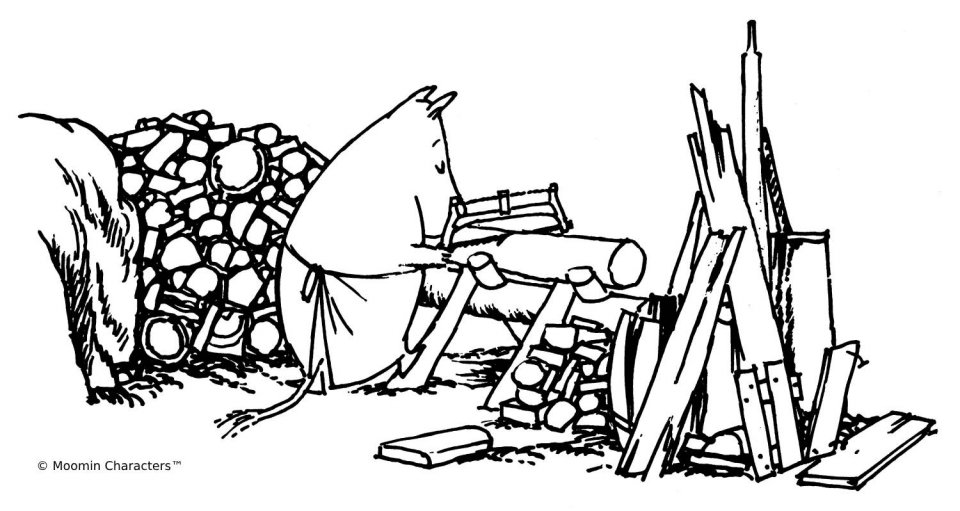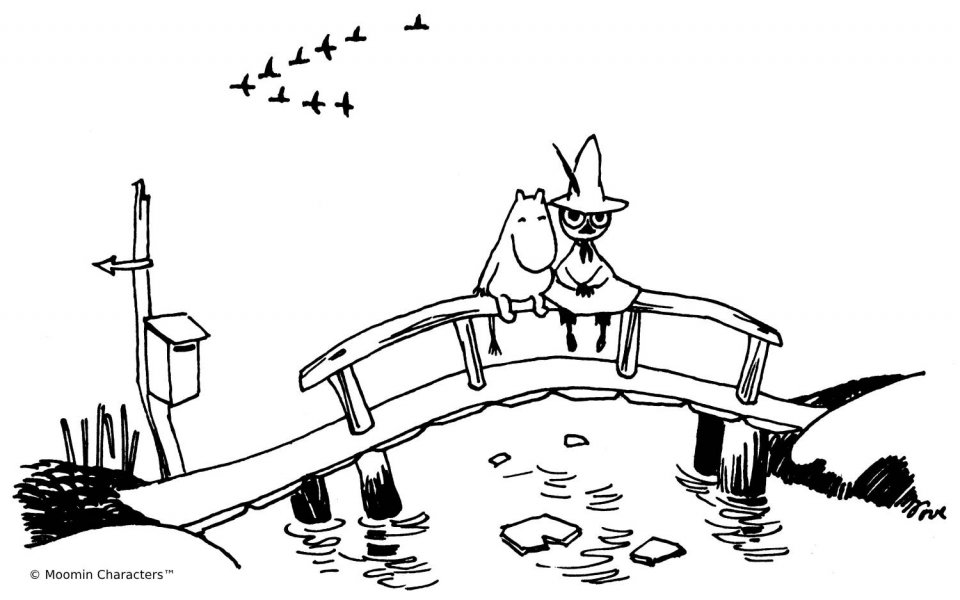This article is a continuation of the its first part written by Sanna Tirkkonen, a researcher who has studied Tove Jansson's work. In these two articles, she examines the themes of loneliness and exclusion in Jansson's work, especially in the novel Moominpappa at Sea (orig. 1965).
Text by Sanna Tirkkonen Academy Research Fellow, Practical Philosophy, University of Helsinki, Images by Moomin Characters
The first part of this article dove into the meaning of loneliness and how it can be interpreted in Moominpappa at Sea; specifically from Moominpappa‘s perspective, as well as in the experience of the fisherman who has lived on the island alone. This article delves into the theme within other characters of the story.
Little My’s idle loneliness
Of the inhabitants of Moominvalley, Little My seems to be doing whatever she wants in the story of Moominpappa at Sea, but themes of loneliness are also present in her part. The book reveals that Little My is an abandoned child used to surviving alone. In addition to her experience of abandonment, Little My can be seen to be dealing with the relationship between loneliness and independence.

Little My is the only character in the novel who doesn’t express any suffering from the family’s distressing situation. She straightforwardly resolves minor conflicts without taking sides, kills ants with burning oil and constantly tries to win over Moomintroll in arguments. Little My’s survival skills include being constantly vigilant and aware of what’s going on between other family members. She is always ahead of the others in her understanding and says outright what the others would rather keep quiet about. Towards the end of the book, Little My seeks the company of the reclusive fisherman and follows his every move, even though he shows no sign of reciprocal interest.
Little My reminds the reader that loneliness is not necessarily a withdrawn or passive state. Indeed, researchers have pointed out that loneliness can even involve a demand for out-of-the-ordinary activity to make contact with other people, even in the most everyday situations. Experiencing a lack of meaningful social relationships creates a constant pressure to connect with others, even if it does not lead to anything more profound.
In the stories of Little My and Moominpappa, one can also see the exploration of loneliness in relation to aggression and anger. Research has paid much less attention to their connection than, for example, the link between loneliness and depression.
Moominmamma’s loneliness in close relationships
In Moominpappa at Sea, the link between loneliness and depression can be explored through the story of Moominmamma. Moominmamma’s loneliness is linked to the lack of contact between spouses and the boredom of life in Moominvalley. Similar feelings can be experienced by anyone going through a relationship crisis or moving to a new place, for example.
Moominmamma is lonely in a new environment where it is difficult to settle. At the same time, Moominpappa is completely absorbed in his own problems, while his spouse remains invisible. At the beginning of the story, Moominmamma tries to remain positive but ends up disappointed. On the island, she cannot do the things that were important to her in Moominvalley. Moominmamma tries to plant flowers, but they cannot live in the rocky soil. Whereas in Moominvalley, Moominpappa felt that his activities are meaningless; on the island, Moominmamma feels she is in the wrong place.
To overcome her boredom, Moominmamma starts sawing logs, but she does it with such fury that she ends up piling up a wall of logs around her. In personal correspondence, Tove Jansson has said that, when writing Moominpappa at Sea, she was examining her relationship with her own mother, Signe Hammarsten-Jansson (1882-1970), which at the time seemed more distant than ever. In her letters, Jansson described her mother’s loneliness, her poor health and how, in her old age, she felt she was in the way of others and cut off from everything.

In the novel, Moominmamma begins to feel better when she finds purpose in her days. She begins to paint on the walls of the lighthouse all the things she misses about Moominvalley. The creative process helps her realise what she actually misses – the painting gives the object of her longing a character. At the same time, Moominmamma begins to identify her negative emotions. She is able to admit that she wants to go home from the wretched island. She doesn’t always have to be the one to keep everyone happy.
After dealing with enough unpleasantness, Moominmamma’s relationship with the island slowly begins to change. She plans to paint the whole island, and eventually, the creative process helps her reorient herself towards the future and a world that can be shared by the whole family.
Moomintroll and difficulties in close relationships
In many Moomin books, Moomintroll misses Snufkin, looking forward to his return and feeling delighted by his letters. In the stories, it is accepted that Snufkin needs his excursions, going away for the winter but always returning in the spring. Yet Moomintroll feels alone when Snufkin is away.
As many readers know, Snufkin has much in common with Jansson’s boyfriend in her youth, Atos Wirtanen (1906-1979). Indeed, the experience of loneliness is sometimes accompanied by loss – a significant relationship that once existed but is now gone. Research has also addressed romantic relationships and how issues within them relate to loneliness.

In Moominpappa at Sea, Moomintroll seeks love and independence from his family. Throughout the story, he reflects on his fear of loneliness and the need to be accepted. From Jansson’s correspondence with her friends, we know that at the time, she was simultaneously dealing with a conflict with her own mother, who found it challenging to accept Jansson’s relationship with Tuulikki Pietilä (1917-2009). The novel Moominland Midwinter is about meeting Too-Ticky, falling in love, creatures in the cupboards – and how Jansson no longer wanted to live a secret life.
Moomintroll’s loneliness on the island is linked to not only the conflicts within the family but also the struggles of a new relationship in a small-minded social climate. Moomintroll, too, carries a secret. He goes to the beach alone at night to wait for the wondrous seahorses surrounded by rainbows. He feels an overwhelming need to tell someone about the seahorses, but the rest of the family only focus on their own concerns. Moomintroll believes that he and the seahorses are united by their love of all that is beautiful. He imagines having poetic and wise conversations with them. In her personal letters, Tove Jansson described Tuulikki Pietilä in almost identical terms.
The anticipation of the seahorses also epitomises Moomintroll’s fear: he fears a kind of love that cannot be explained and that even his own family cannot understand. When the sea horses finally arrive, they laugh with a shrill voice and mock Moomintroll. Moomintroll’s loneliness is indeed linked to avoiding being hurt, fearing that the external splendour of the sea horses does not correspond to their internal reality.
When Moomintroll waits on the shore, the Groke arrives, freezing everything around her. The Groke has sometimes been interpreted as a symbol of the unconscious, but she can also be interpreted as loneliness itself.

On the way to the island, Moomintroll tries to talk to his mother about the Groke and loneliness, but Moominmamma only responds by saying it shouldn’t be talked about or the Groke will only grow. When the whole family finally find each other again and begin to feel better, even the melancholic Groke starts to dance and sway her skirts – even the ground beneath her no longer freezes. All along, in trying to approach the Groke, Moomintroll has been trying to confront his own fear of loneliness.
Small steps out of loneliness
The loneliness of the Moomin family in Moominpappa at Sea is a passing crisis, but this is certainly not the case for everyone. Not everyone has a family or loved ones to turn to. For example, Tove Jansson’s novel Moominvalley in November addresses how to establish new connections when one cannot rely on loved ones. Loneliness should be understood as a broad social issue, the severity of which is significantly influenced by how social relations – such as housing, care, and work-life – are organised in society.
Loneliness comes with a lot of shame, and experiencing it subtly affects how a person perceives opportunities to be in the company of others and be accepted. For this reason, in organisational efforts to prevent loneliness, it is essential to remember that loneliness is often best alleviated through activities that do not overly emphasise participants’ longing for the company of others but instead offer low-threshold opportunities for meaningful activities – and at the same time, engagement with others.
It is possible to break free from even the deepest loneliness, but perhaps not without help. Moominpappa at Sea also models this. Towards the end of the story, the reunited Moomin family approaches the lonely fisherman on the island and begins to spend time with him. At first, it is difficult for the fisherman to be in the company of the Moomins, but they give him time and accept him just as he is. Gradually, the presence and warmth of the Moomin family help the fisherman get out of his shell and remind him of who he really is – and so the light of the forgotten lighthouse shines again.
Read more about the collaboration of Moomin Characters and the Finnish Red Cross here.
Sources:
Jansson, Tove: Moominvalley in November (orig. 1970), Comet in Moominland (orig. 1946), Moominpappa at Sea (orig. 1965), Tales from Moominvalley (orig. 1962), Finn Family Moomintroll (orig. 1948), Moominland Midwinter (orig. 1957)
The author is a postdoctoral researcher at the University of Jyväskylä and the University of Helsinki, currently working as a visiting researcher at Heidelberg University Clinic in Germany. In 2019, she won the Kone Foundation’s Science Writing of the Year award for her article on the feelings of loneliness in Tove Jansson’s work “Moominpappa at Sea,” published in the Psychotherapy Journal.

Comet in Moominland – the first “real” Moomin book
Comet in Moominland is a book packed with adventure and excitement – centered around a comet, which threatens to destroy the Moominvalley.

A treasure trove of Moomin book quotes for every moment of life
Explore a curated collection of Moomin quotes within the themes of friendship and love, adventure, resilience, celebration, and joy.

Moomin friendship skills – free learning material by The Red Cross now in five languages
In the Friendship skills with the Moomins learning material produced by the Finnish Red Cross, children learn friendship skills through functional games, animations as well as mindfulness and discussion exercises.
